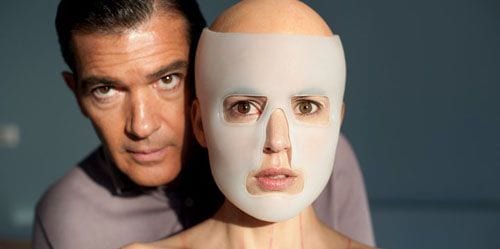
The first few minutes of Pedro Almodóvar ‘s La Piel Que Habito (The Skin I Live In) suggest an intricate plot. Robert Ledgard (Antonio Banderas) has genetically engineered a new type of skin, resistant to fire and malaria-infested mosquito bites, among other things. He’s dedicated this work to the memory of his wife, who burned to death in a car accident — or did she?
This question hovers, as you learn that Ledgard, a plastic surgeon living in Madrid, in working on the skin, broke bioethics laws forbidding transgenesis and experimenting on humans. He’s been testing on a mysterious woman, Vera (Elena Anaya), who lives in a locked room in his house, under strict observation of the maid Marilia (Marisa Paredes). Vera’s entire body surface is covered with the new skin, over which she wears a protective skin-colored bodysuit. The doctor watches her on a giant monitor as she moves around her room. Vera is entirely Ledgard’s creation, his work of art. And, yes, she looks a lot like his dead wife.
Almodóvar insisted at his Cannes press conference that La Piel Que Habito is “not science-fiction,” given that human genome experiments have become a reality. He also announced that he has entered a “thriller” period, influenced by Fritz Lang, as well as Franju’s definitively creepy Les yeux sans visage (Eyes Without a Face).
Though its formal parameters may be different for Almodóvar, the themes of La Piel Que Habito are familiar, including family dysfunction, sexual transgression, and shifting gender identities. Vera is a Frankenstein’s monster, surgically and genetically engineered to fulfill Ledgard’s revenge fantasy. The movie traces how he’s come to this desperate point, cutting to six years ago. Here a brash young store window designer, Vicente (Jan Cornet), meets and tries to seduce Ledgard’s daughter Norma (Blanca Suárez) at a party. He’s high on drugs, she’s full of prescription pills, and the encounter goes badly.
The Artist
At his press conference, Almodóvar said he considered making La Piel Que Habito as a black and white, silent film. It happens that Michel Hazanavicius’ The Artist opens on the premiere of just such a film, with a live orchestra. The film crew awaits the audience reaction behind the screen in the theater. When the audience applauds, behind the screen, the star, George Valentin (Jean Dujardin), turns to the producer, Zimmer (John Goodman), to congratulate him. He speaks. We hear nothing.
The rest of The Artist elaborates on this layering of art and life. For the most part, it proceeds as a typical silent film, with orchestral accompaniment. But occasional effects — a dropped glass, a dog barking — interrupt this fiction. Increasingly, though characters around Valentin find their voices, he remains silent. It turns out that he’s one of those legendary silent stars whose career crashed in the sound era because he refused to talk, on the screen and in life, a point underscored when his wife Doris (Penelope Ann Miller) leaves him, saying, “We never talk any more.”
The Artist is Hazanavicius’ first film in Official Competition at Cannes. The director is known best known for successful lowbrow parodies of 1960s spy movies, including OSS 117: Cairo, Nest of Spies, starring Dujardin and Bérénice Béjo, who also appears in The Artist as a dancer who becomes a talkie sensation. Though The Artist makes some fun of the old studio system, it is more of an homage rather than a parody. It offers heartfelt romance and even a cute dog to save the day, with storylines referencing A Star Is Born and Ginger Rogers and Fred Astaire movies. The film’s inclusion in official competition is itself something of a revision in a longstanding system: in recent years, most such spaces have been taken up by long-time participants and past prizewinners.

![Call for Papers: All Things Reconsidered [MUSIC] May-August 2024](https://www.popmatters.com/wp-content/uploads/2024/04/all-things-reconsidered-call-music-may-2024-720x380.jpg)



